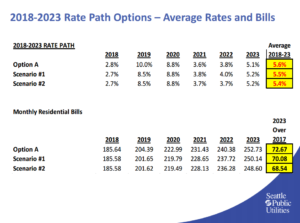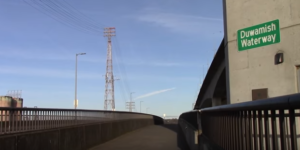Resolution on High-Earner Income Tax, SPU SBP Committee Update, West Seattle Bridge Studies, And speaking of Bridges, South Park’s Green Walls to Clean Air
Resolution on High-Earner Income Tax
Seattle is a growing and prosperous city that should offer better schools and healthier communities, yet our City faces many urgent challenges, including a homelessness state of emergency, an affordable housing crisis, overcrowded classrooms, education equity and racial achievement gaps, inadequate provision of mental health services, and severe traffic congestion.
Because there are real risks that the Trump administration will cut funding for Seattle priorities like housing and human services, education and transit, the Trump-Proof Seattle Coalition of more than 40 different organizations has come together to fight back. They have been meeting with Councilmembers in every district to propose an income tax on high earners.
Residents have contacted my office in recent months in shock over the increase in their property taxes. It’s our tax structure that is responsible; Washington State’s is the most regressive in the nation, with people earning $20,000 a year devoting two entire months of pay to their yearly tax bill, while the 1% pay their annual tax bill in only 6 days. We need a fairer tax system. Economist Dick Conway reports that across five different measures – fairness, transparency, adequacy, stability, and economic vitality – Washington State’s tax structure is the worst of all the states in the nation.
- Fairness – we have the most regressive system, meaning the tax burden is greatest on those with lower incomes (see above)
- Transparency – we don’t know how much we pay in taxes because so much is buried in the sales tax. Transparency is a prerequisite for rational tax policy. Washington has the second least transparent tax system in the nation.
- Adequacy – our tax system doesn’t generate enough revenue to meet the public needs (e.g., education and transportation) of a growing economy – resulting in over-reliance on the property tax levies.
- Stability – Washington has a highly unstable tax system due to its inadequate and volatile sales tax base, the ninth most unstable in the nation.
- Economic Vitality – many economists believe that the best way to promote economic vitality is with high-quality education, good roads, and a safe and healthy environment. There is no evidence that having an income tax is an impediment to economic growth and there is a lot of evidence that the lack of an income tax has put our economy – not to mention our schools – in jeopardy.
On Monday, the Council will consider a resolution “expressing the City of Seattle’s intent to adopt a progressive income tax targeting high-income households.”
The resolution lays out a timeline and the elements of the legislation that need to be determined, including: what types of income can and will be taxed; the threshold above which income is taxed, and/or below which households are exempted from the tax; at what percentage(s) income is taxed; the use of the revenue so raised; and the administrative mechanisms to ensure the accurate and enforceable collection of income tax revenues.
The resolution notes that legal viability will be the primary consideration in making these decisions.
It further notes that “revenue from such a systemic change in taxation could be dedicated to lowering the property tax burden and the impact of other regressive taxes; replacing federal funding potentially lost through Trump budget cuts; and providing public services, including housing, education, and transit; creating green jobs and meeting carbon reduction goals.”
The Trump-Proof Seattle Coalition proposal is a 1.5% tax on adjusted gross income in excess of $250,000 per year. They estimate this could raise $125 million annually. On Thursday, May 4th they are coming to District 1 at South Seattle Community College, Olympic Hall. I’ll be there. Doors open at 5:30. Program begins at 6pm and Childcare is available. Campus map here: http://www.southseattle.edu/campus-information/campus-map.aspx
SPU Strategic Business Plan Committee Update
On Tuesday my Civil Rights, Utilities, Economic Development, and Arts (CRUEDA) committee received an update from Seattle Public Utilities (SPU) about their steps towards updating their Strategic Business Plan (SBP), passed by the Council in 2014. The SBP is a six-year outlook and guiding document for the utility. It is adjusted every three years to reflect the most accurate information about projects and costs and the utility rates needed to support those project costs. The process begins with a nine member, all volunteer Customer Review Panel (CRP). They are appointed to act as the voice of the utility rate paying customer during the planning and development stages of the SBP.
Among other things, the SBP projects the rate path for all lines of business in SPU. This includes: water, wastewater, drainage, and solid waste. In the previously adopted 2015-2020 SBP, the anticipated combined (water, wastewater, drainage, and solid waste) annual rate increase would average 4.6% over each of the 6 years. We learned in the CRUEDA committee presentation that the combined annual growth rate increase that they are studying for the update to the SBP ranges instead from 5.4% – 5.6%.
This potential increase is due to several reasons: first, in 2015, shortly after the first SBP was passed, the Port of Seattle stopped being a customer of SPU and created their own utility and, consequently, stopped paying SPU $4 million annually for their services. Secondly, a federally mandated consent decree from the Environmental Protection Agency required the acceleration of a combined sewer overflow pipeline in Ballard, called the Ship Canal Water Quality project. It is estimated to cost $365 million. Finally, the Move Levy, passed by voters in 2015, creates an opportunity to access the Utility’s infrastructure while the roads are being repaved. SPU refers to them as opportunity costs and estimates $116 million in transportation opportunity costs that the Utility is proposing that we spend now, to save more money later. The combination of those three issues means that SPU has taken the position that the previously projected 4.6% combined (water, wastewater, drainage, and solid waste) average per year rate increase is no longer feasible.
Last Fall, when the CRP was assembled and began their work, SPU started with a proposed combined (water, wastewater, drainage, and solid waste) rate increase of an average of 6.8% a year for the 2018 – 2023 SBP. Since then they have worked to bring the possible rate increase estimates that they are studying down to between 5.4% and 5.6%. Please see the graph below for specific year over year percentages and monthly bill estimates for the options that the CRP is currently considering.

The CRP is continuing their work, meeting twice monthly with SPU to work on a final recommendation which they will send to the Council and Mayor at the end of May. They are continuing to identity additional efficiencies and prioritization of projects that will hopefully result in a maintained quality of service balanced with the need for more affordable rates than the increased currently being considered. That recommendation will then be heard in my committee several times and the Council will continue to refine the SBP before final passage.
Finally, I would like to highlight the important analysis that was conducted by Council policy staff which can be found here. Table 2 in this memo highlights the peeks in rates for 2019 and 2020 when both the Ship Canal Water Quality project and the transportation opportunity costs would hit the rate payers. I would like to see the increases spread out more over the six years so that rate payers do not receive particularly large increases in any one year.
Expect updates from me on this issue in future, and please email me to let me know your thoughts.
The Seattle City Council has commissioned six studies of the West Seattle Bridge corridor, called for in the West Seattle Bridge/Duwamish Waterway Corridor Whitepaper prepared for former Councilmember Tom Rasmussen in 2015, to improve safety, incident management, and traffic flow on the West Seattle Bridge and the lower bridge.
This study covers the area from the West Seattle Bridge and Spokane Street Viaduct to I-5 (including the lower roadways). Four studies were funded in 2015, sponsored by Rasmussen. I secured funding for the remaining two in 2016. The
These four studies have recommendations to:
1) manage the daily unpredictable disruptions on the lower roadway
2) reduce crashes on the upper bridge
3) reduce incident clearance times to restore normal traffic.
Recommendations include improvements for managing congestion on lower Spokane Street, such as real-time information on swing-bridge openings, a Terminal 5 gate queue management agreement, an active traffic management system, and constructing refuge pullouts. Cost estimates are listed at the end, on page 24. I’ll be looking for ways to work with SDOT to implement these recommendations.
The report recommended against a median gate to allow emergency vehicles to make U turns, or for emergency/fire lane striping. The studies are linked here.
I’d like to thank SDOT for installing “Duwamish Waterway” signs on the upper and lower bridges, to mark the crossing to West Seattle. Last year I received a request from the Southwest Seattle Historical Society about noting this, especially given the importance of the Duwamish as the original residents. I asked SDOT about this, and they installed the signs earlier this month.

Image: Clay Eals
South Park’s Green Walls to Clean Air
Martha Baskin’s Immigrant Community Designs “Green Walls” to Clean the Air, The Only Walls They Favor aired on April 20th and explores the green walls being installed in South Park to help clean up air pollution. As a historically industrial and underserved neighborhood South Park has dealt with many different kinds of pollution for a long time. Asthma rates are more than double for young people and life expectancy is 13 years lower than wealthier parts of Seattle. The community has come together to work with the City, County, EPA, and other organizations to find solutions to these problems. The green wall was supported by funds from the Duwamish River Opportunity Fund that provides support to programs focused on challenges faced by Duwamish River neighborhoods during the Superfund clean-up
Here’s an excerpt:
“Beneath hand-crafted green wall panels on the site of a public library, youth in Seattle’s South Park immigrant community plant honeysuckle, jasmine and clematis. Soon their leafy vines will climb metal cables welded onto the panels. When fully grown, the green walls will filter particulates and help clean the air in a neighborhood dominated by highways, air traffic and industry.”
The community is shifting their focus after planting 700 trees over the last year and a half. Green walls are the second phase of the plan to reduce air pollution for the area. Green walls are a new concept for many people, but as more people learn about them the more they get engaged. The Port of Seattle and the South Park Merchant Association are in talks about building more green walls in South Park and Georgetown.
You can read the previous green wall press release from the Duwamish River Cleanup Coalition here and you can listen to Martha Baskin’s report here.
Posted: April 28th, 2017 under Councilmember Herbold, Education, Homelessness, Libraries, Public Health, Seattle Public Utliities, Transportation, West Seattle Bridge
Tags: bridges, Seattle Public Utilities, South Park, tax, West Seattle Bridge

